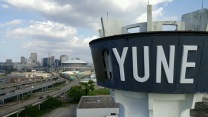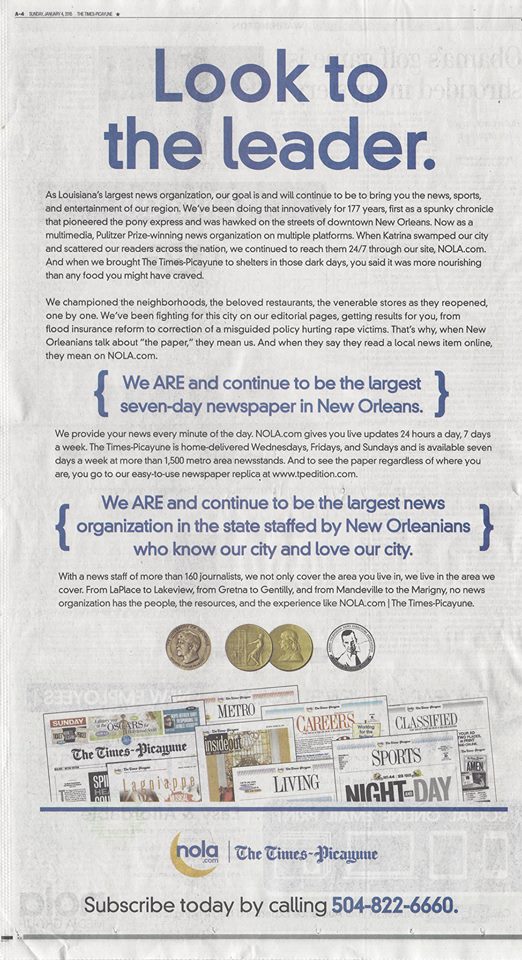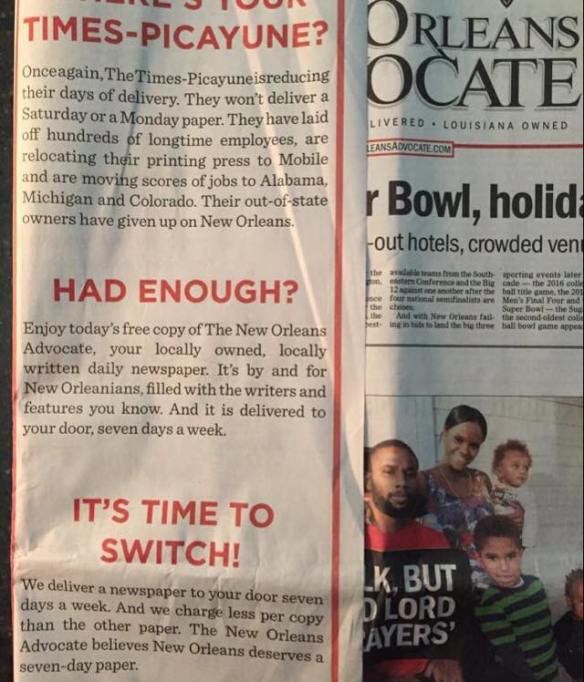
Banner story in The Times-Picayune four years ago today by newly named publisher Ricky Mathews, promising the-then 175-year-old newspaper and its newer website would remain a fixture in New Orleans.
As New Orleans prepares to commemorate the 10th anniversary of Hurricane Katrina on Aug. 29, most media watchers assume The Times-Picayune will produce its own retrospective on the sacrifice many of its staff made in chronicling the storm and its aftermath, work that led to two Pulitzer Prizes, countless other national and international awards, and worldwide praise.
Instead of somber contemplation about the greatest natural and engineering disaster in U.S. history and the newspaper’s role in documenting it, it seems that remaining employees at the once-revered 178-year-old publication will be consumed with avoiding the ax as staff cuts once again strike the operation.
Alternative Gambit Weekly reported today that Director of State and Metro Content Mark Lorando this week met with small groups of employees about the coming layoffs, describing them to at least one colleague as “deep.”
“They’re being pretty upfront,” one newsroom staffer told Gambit Editor Kevin Allman, who along with The New York Times’ late media reporter David Carr, led coverage of the 2012 dismantling of the newspaper. Another T-P staffer joked grimly to Allman that it may be “2012 redux” — referring to when hundreds of Times-Picayune employees, freelancers and contractors lost their livelihoods in support of corporate owner Advance Publications’ new “digital first” strategy.
An estimated one-third of Times-Picayune employees lost their homes because of flooding caused by the region’s failing levees in the aftermath of Katrina. (Katrina is a major character in Hell and High Water, and Chapter 4 is devoted to the response to the storm by The Times-Picayune’s staff and its role in the newspaper’s contemporary legacy. The book also details the company’s regular invocation of Katrina when defending or explaining the need for digital first, references that more than irked many employees and the community.)
Many Times-Picayune reporters and photographers lauded for their coverage of Katrina and its aftermath were laid off during the 2012 purge, and many more either left the market or business, or jumped ship to join The Advocate newspaper of Baton Rouge after it was acquired by New Orleans billionaire John Georges and expanded into New Orleans later that year. (Those defections are detailed in Chapter 5 of the book.) About 50 now listed on NOLA.com’s online staff list remain from 2005.
The latest restructuring will occur “in the latter half of 2015” – perhaps around the time of the Katrina anniversary – and be completed by early 2016, “sources with knowledge of the plan” told Allman.
Because of the company’s preoccupation with website traffic to NOLA.com, the 2012 layoffs spared functions generally responsible for generating the largest share, namely sports, features and entertainment/arts. However, it appears there will be no sacred cows in the coming layoffs, Gambit reported, although it’s unclear whether duplicate positions in New Orleans and Alabama, like copy editors, will be consolidated, perhaps at corporate owner Advance Publications’ newspapers in Mobile or Birmingham. (Much of the Picayune’s copyediting operation – once the quality control hub of newspapers – was eliminated in 2012. Careful readers regularly detail mistakes and errors that plague the website and printed edition, sometimes serious blunders that historically often would have been caught and corrected by copyeditors before publication.)
“Also unclear when it comes to the [impending layoffs]: how much weight will be placed on each writer’s ‘clicks’” — a count of how many reader views a reporters’ stories garner — “which are closely tracked within NOLA Media Group,” Gambit reported.
The alt-weekly’s report followed one on NOLA.com Monday (June 15) in which the company announced its operations in Louisiana, Mississippi and Alabama would be consolidated into Advance’s newly established Southeast Regional Media Group. In addition to The Times-Picayune, Advance owns the Huntsville Times, Birmingham News and Mobile Press-Register in Alabama, and the Mississippi Press, along with scores of other newspapers around the country that largely also have been subjected to “digital first.”
Although NOLA.com’s story didn’t specify where the new regional operations would be headquartered, Gambit reported that most T-P staffers expect it to be in Mobile. Last fall, the company announced that the newspaper will shutter its presses in favor of printing the newspaper on the Press-Register’s presses some 145 miles away, beginning later this year or early in 2016. Those layoffs or jobs transfers are either still underway or recently concluded, according to social media posts from friends of those employees. That move will cost The Times-Picayune another 100 jobs and prompt closure of the newspaper’s building and iconic clock tower along the city’s Pontchartrain Expressway. Once all operations have been relocated, execs have said the building will probably be donated to a New Orleans nonprofit.
An operational move to Mobile also makes sense because Ricky Mathews, president

Fliers that popped up around town shortly after Mathews’ was appointed publisher of The Times-Picayune in 2012.
and publisher of NOLA.com | The Times-Picayune recently promoted to head the new regional company, has a long history on the Gulf Coast, and operating expenses are probably lower there. Mathews has been widely vilified in New Orleans since arriving in 2012 to oversee the newspaper’s draconian transformation, and in the understatement of Gambit‘s latest report, has “failed to ingratiate himself among the rank and file.” (Chapters 6 and 9 in the book deal specifically with Mathews’ rocky tenure in New Orleans, and his earlier career in Mobile and Biloxi, Mississippi.)
However, “whatever detractors say about the print-to-digital swing in New Orleans, the company is happy with the job Ricky Mathews has done there,” said Rick Edmonds, media business analyst at journalism think tank and continuing education center Poynter Institute said Monday.













